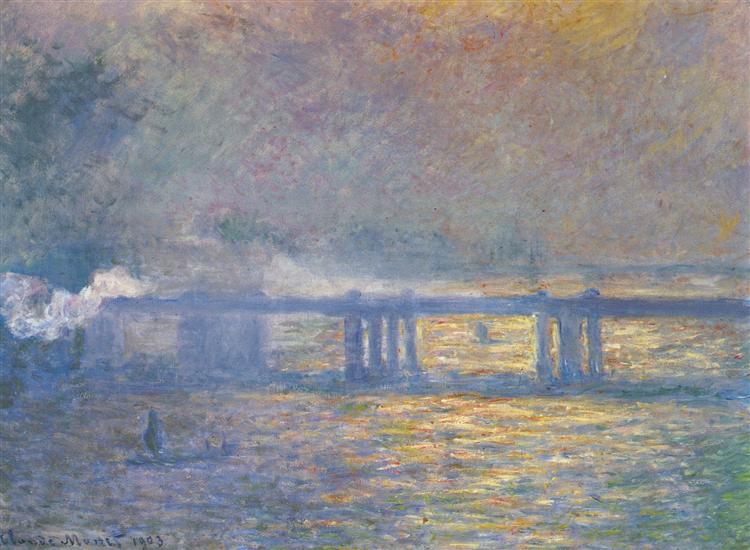Descriere
Claude Monet's painting "Charing Cross Bridge" (1903) encapsulates the essence of the Impressionist style through its treatment of the cityscape and masterful use of light and color. Part of a series of works Monet dedicated to London's bridges, this piece is distinguished by its vaporous atmosphere and lyrical interpretation of the metropolitan environment, a subject that was relatively new to his career at the time.
In this work, Monet presents a view of the bridge spanning the River Thames, an icon of London architecture. The composition invites the viewer to immerse themselves in a scene where the structure of the bridge stands out in an ethereal way, almost in a state of dissolution in the mist and light that surrounds it. Monet uses a color palette that varies from deep blues and silvery grays to warm ochres and oranges, creating a luminous contrast that highlights not only the structure of the bridge, but also the changing and dynamic atmosphere of the city.
A distinctive feature of the work is its depiction of light reflected in the river waters. The loose, vaporous brushstrokes Monet employs convey a sense of movement and the immediacy of the visual experience. The surface of the water becomes a restless mirror of bright and subtle hues, alluding to the transience of the scene. This way of treating water is characteristic of the Impressionist style, where the focus is not on a detailed portrait, but on capturing the moment and the light.
Monet does not include any human figures in this painting, suggesting a search for serenity in the landscape or perhaps a contemplation of the architecture itself, isolated in its splendor. However, the bridge serves as a symbol of connection, suggesting that despite the absence of human activities, the urban environment is imbued with life and movement. This intentional absence of figures could be interpreted as a reflection on modernity, where even public spaces can seem stripped of the human, focusing solely on the interplay of light and form.
The period in which Monet painted Charing Cross Bridge was one of exploration and experimentation, where the boundaries of artistic representation were constantly expanding. This work is set within a period when Monet was grappling with the capture of light and its effects on the landscape, a theme he began to explore in his famous landscapes of the Water Lilies series and Rouen Cathedral. Monet's work is not only a testament to his technical mastery, but also a reflection on modernity and the changes in the perception of the urban environment in the context of the early twentieth century.
Charing Cross Bridge thus stands not just as a painting of a bridge, but as a meditation on light, space and time. It is a clear example of Monet's drive to articulate the visual experience of his surroundings, turning a simple crossing into an almost dreamlike experience, where the ephemeral nature of human experience collides with the immobility of architectural structure. This work, in its delicate interpretation of emerging modernism, continues to resonate with the contemporary viewer, inviting them to experience their own relationship with light and environment. In it, the little bridge at Charing Cross is transformed into an eternal crossing between past and present, between the tangible and the intangible.
KUADROS ©, a famous painting on your wall.
Hand-made oil painting reproductions, with the quality of professional artists and the distinctive seal of KUADROS ©.
Painting reproduction service with satisfaction guarantee. If you are not completely satisfied with the replica of your painting, we will refund 100% of your money.

